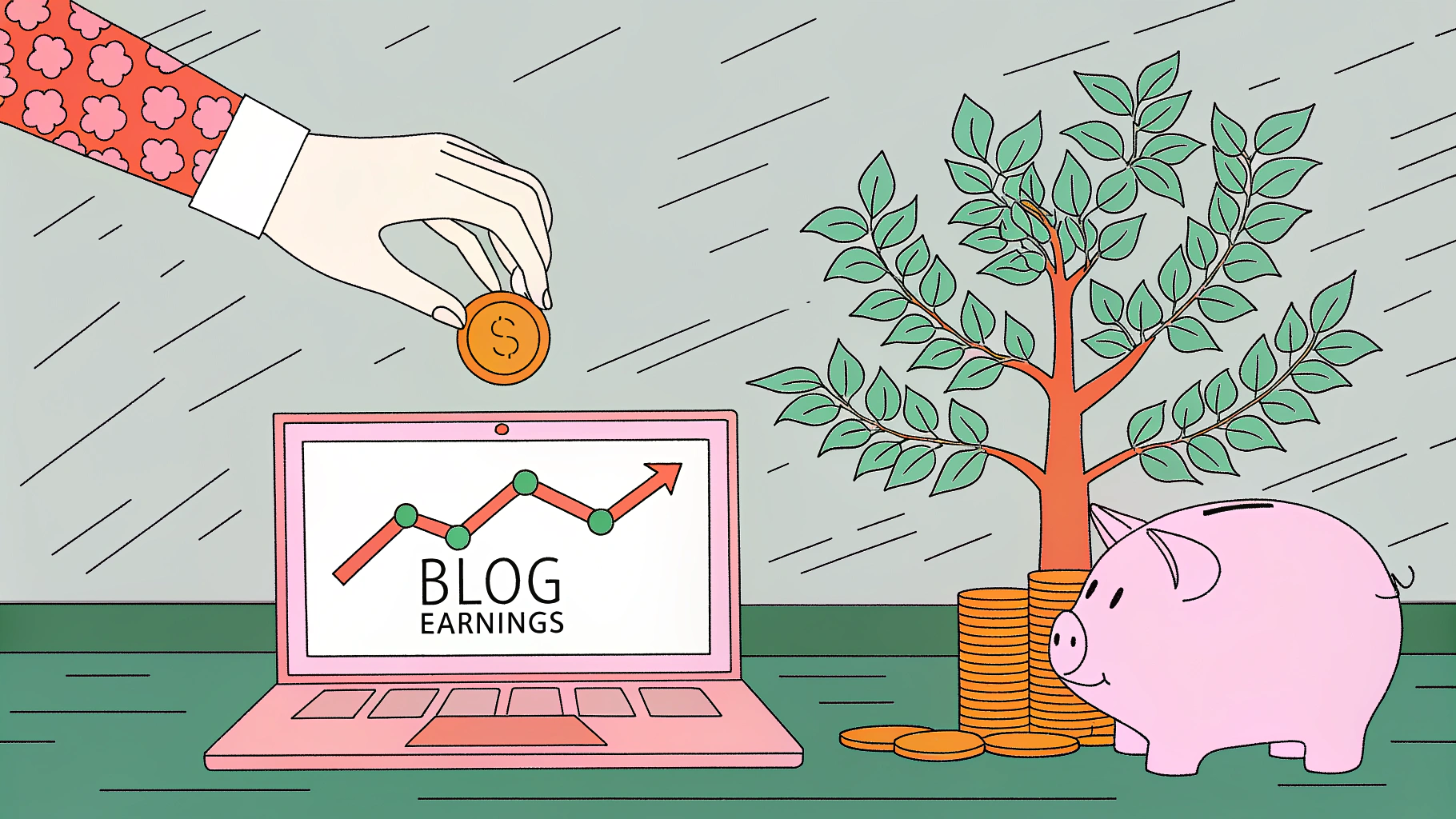Can You Really Make Money From a WordPress Blog?
Let’s be real—if you’ve ever typed “how to monetize WordPress blog” into Google, you’ve probably seen a mix of wild income claims, frustrated Reddit rants, and a few folks quietly making bank. The truth? Most bloggers hit a wall when they try to turn their site into a money machine. There’s this one Reddit thread where someone with under 1,000 visitors was running thousands of ads and barely making coffee money. The replies? Brutal. People said you need “hundreds of thousands of visitors” for ad revenue to matter, and a bunch of folks just gave up. It’s a mess out there.
But here’s the thing: WordPress blogs absolutely can make real money. Some bloggers pull in $3,000, $5,000, even $10,000+ a month—no joke. The catch? You need the right blog monetization strategies for your traffic and your audience. If you’re trying to slap AdSense on a brand new blog, you’ll probably get pennies. But if you pick the right method for your size and niche, you can start seeing real WordPress blog income way sooner than you think.
Here’s what most people get wrong: they pick the wrong monetization method for their blog’s stage. New bloggers try to run ads (which need big traffic), while bigger blogs sometimes ignore high-ticket affiliate programs or digital products that could double their income. The WordPress.com support docs even break it down—some monetization options need a paid plan, and some work on any site. It’s not one-size-fits-all.
And let’s not forget the most important part: your audience. The MobiLoud guide says it straight—if you don’t have a loyal audience, you’re not making money, period. You need to know what your readers want, what they’ll pay for, and how to build trust. That’s the real secret sauce behind every successful blog.
This guide is different. We’re not just listing a few ways to make money—we’re giving you 15 proven strategies that actually work in 2025. Whether you’re just starting out or you’ve got a blog with thousands of fans, you’ll find something here that fits. We’ll talk about everything from affiliate marketing to membership sites, digital products, and even some weird (but profitable) alternatives.
And if you want to skip the guesswork? Republish AI’s tools can help you find high-converting topics, write content that actually sells, and optimize your old posts for more revenue. Their AI Agent Atlas and Nova are like having a nerdy research assistant and a copywriter who never sleeps. It’s a game-changer for anyone serious about WordPress blog income.
Before we get into the nitty-gritty of making money, you need to understand the foundation—how traffic, audience, and the right strategy set you up for success. Otherwise, you’ll just end up another frustrated Reddit post. Let’s talk about what you really need to get started.
If you’re itching to monetize your WordPress blog, here’s the thing nobody wants to admit: traffic and audience quality are everything. You can slap ads or affiliate links all over your site, but if nobody’s reading—or if your readers don’t care—your blog traffic monetization dreams are going nowhere fast. Before you even think about revenue, you need a real audience. Not just random clicks, but people who trust you, come back for more, and actually want what you’re offering. Let’s break down what that means in 2025, and how you can set yourself up for real WordPress revenue optimization.

Understanding traffic requirements for different monetization methods
One of the biggest mistakes new bloggers make? They try to run before they can walk. You see folks on Reddit asking why their AdSense earnings are stuck at $2 a month, or why nobody’s buying their $99 eBook. The answer is almost always the same: not enough of the right people are seeing your stuff. Different monetization strategies need different levels of traffic and engagement. Here’s a quick cheat sheet to keep you from wasting time on the wrong method:
Monetization Method | Minimum Traffic Recommended | Potential Monthly Income |
|---|---|---|
Display Ads | 10,000+ monthly visitors | $50-$500 |
Affiliate Marketing | 1,000+ monthly visitors | $100-$1,000+ |
Digital Products | 500+ email subscribers | $200-$2,000+ |
Sponsored Posts | 5,000+ monthly visitors | $100-$500 per post |
Membership/Subscription | 1,000+ engaged followers | $500-$5,000+ |
Notice something? Display ads need a ton of traffic to make even a few hundred bucks. Affiliate marketing and digital products can work with way less, but only if your audience actually cares about what you’re selling. And for memberships or subscriptions, it’s not about raw numbers—it’s about having a core group of people who’d miss you if you disappeared. That’s the so-called “2025 true fans” idea: you don’t need a million readers, just a thousand who really trust you.
Creating content that attracts a monetizable audience
Let’s get real: not all traffic is created equal. You could have 20,000 visitors a month from random Google searches, but if they’re just looking for a quick answer and bouncing, you’ll struggle to monetize. What you want is an audience that’s hungry for solutions—and trusts you to deliver. Here’s how you get there:
Pick a niche that pays. Some topics are just easier to monetize. Finance, tech, health, and hobbies with expensive gear (think photography or cycling) tend to attract readers who spend money. If you’re writing about free stuff or general news, it’s a slog to make real income.
Write content that solves real problems. The best monetized blogs don’t just entertain—they answer questions, fix headaches, or help people make decisions. For example, a post like “Best WordPress eCommerce plugins for small businesses” naturally leads to affiliate links and product recommendations. A rant about your day? Not so much.
Build trust by showing up consistently. People buy from bloggers they trust. That means posting regularly, sharing your own experiences (even the messy ones), and not shilling every product under the sun. If you’re just chasing commissions, readers will sniff it out and bail.
And don’t forget: engagement matters as much as traffic. A blog with 1,000 die-hard fans can out-earn a site with 10,000 random visitors. That’s why you see some tiny niche blogs pulling in $2,000 a month, while bigger sites barely scrape by. It’s all about quality over quantity.
Using Republish AI to optimize content for monetization
Here’s where things get interesting. Most bloggers waste hours guessing what to write about, or tweaking old posts that never convert. Republish AI flips that on its head. Their tools are built to help you find what actually makes money—and then create content that gets results. Here’s how it works:
AI Agent Atlas digs up profitable topics and keywords. Instead of guessing what your audience wants, you get a data-driven list of what’s working right now in your niche. No more writing 20 posts that flop before you find a winner.
AI Agent Nova helps you write content that actually converts. It’s not just about stuffing in keywords—it’s about crafting posts that lead readers naturally to your affiliate links, product pages, or sign-up forms. Nova can even help you sound more like yourself (and less like a robot).
AI Blog Editor takes your old posts and gives them a revenue-focused makeover. Maybe you’ve got a post that ranks but doesn’t sell—this tool can help you add calls to action, improve your internal linking, and boost your conversion rates. It’s like having a blog traffic monetization coach on call.
- Identify high-converting keywords and topics (no more wild guesses)
- Create content that naturally leads to monetization opportunities (not just filler)
- Optimize existing content for better conversion rates (turn duds into cash cows)
- Save time on research and writing so you can focus on your monetization strategy (or just take a nap, honestly)
Bottom line? Consistency and patience win. Most blogs don’t make money overnight. But if you focus on building a real audience, creating content that solves problems, and using tools like Republish AI to work smarter—not harder—you’ll be way ahead of the pack. WordPress revenue optimization isn’t magic, but it’s not rocket science either. Just don’t expect to get rich off 500 random clicks a month. Build your foundation, and the money will follow.
15 Proven Ways to Monetize Your WordPress Blog
Let’s get real: making money from a WordPress blog isn’t magic, but it’s not a pipe dream either. You just need the right mix of strategies, some patience, and a willingness to experiment. Below, I’ll break down 15 ways people are actually earning WordPress blog income in 2025—no fluff, no empty promises. Each method comes with practical steps, plugin picks, and what you can realistically expect to earn (not those wild numbers you see on Twitter threads).
Advertising revenue strategies (Methods 1-3)
Display ads are the classic way to monetize a WordPress blog, but they’re not a goldmine for everyone. If you’re hoping to get rich with Google AdSense and you’ve got 500 visitors a month, you’re in for a rude awakening. Still, ads can be a solid part of your income mix—if you play it smart.
1. Google AdSense and display advertising
Google AdSense is the go-to for most new bloggers. It’s easy to set up and works on almost any WordPress site. But here’s the catch: you need real traffic. Reddit threads are full of people making $5 a month with 1,000 visitors. You’ll need at least 10,000 monthly visitors to see anything meaningful—think $50 to $500/month, depending on your niche and audience location.
- Sign up for a free Google AdSense account.
- Install a plugin like Advanced Ads or Ad Inserter to manage ad placements.
- Paste your AdSense code into the plugin and choose where ads appear (sidebar, in-content, header, etc).
- Monitor your WordPress ad revenue in the AdSense dashboard.
- Tweak ad placements for better click-through rates (but don’t go overboard—too many ads = annoyed readers).
Pro tip: If your blog is about finance, tech, or health, you’ll usually get higher ad rates. Hobby or general lifestyle blogs? Not so much.
2. Premium ad networks (Mediavine, AdThrive, SHE Media)
Once you hit 50,000+ monthly sessions, you can apply to premium networks like Mediavine or AdThrive. These networks pay way better than AdSense—sometimes 2-5x more per 1,000 views. But they’re picky. If you’re not there yet, don’t sweat it. Focus on growing your traffic.
- Grow your blog to at least 50,000 sessions/month (Mediavine) or 100,000 (AdThrive).
- Apply directly on their websites. Be ready to show your Google Analytics stats.
- If accepted, they’ll help you set up their ad code (usually via a plugin or header script).
- Use their dashboard to track earnings and optimize ad placements.
- Follow their content and ad placement guidelines to avoid getting booted.
Income: $10–$40+ per 1,000 sessions is common. Some food bloggers make $2,000–$10,000/month just from ads, but only with big traffic.
3. Direct ad sales to businesses
If you’re in a tight niche (think: local real estate, pet grooming, or vegan baking), you can skip the middleman and sell ad space directly to brands. This means you set your own rates and keep all the money. It’s more work, but the payout can be much better.
- Identify brands or local businesses that want to reach your audience.
- Create a simple media kit (traffic stats, audience demographics, ad options, pricing).
- Reach out via email or LinkedIn. Be specific about what you offer.
- Use a plugin like AdSanity or Advanced Ads to manage and rotate banner ads.
- Invoice clients monthly or quarterly. Use PayPal, Stripe, or direct bank transfer.
Income: $50–$500/month per ad slot is typical for small-to-medium blogs. If you’re in a lucrative niche, you can charge more. Just don’t promise what you can’t deliver—brands will bail if they don’t see results.
Affiliate and sponsored content (Methods 4-6)
Affiliate marketing is where a lot of smaller blogs actually make real money. You don’t need a million visitors—just a loyal audience that trusts your recommendations. Sponsored content is another way to cash in, especially if you’ve built a reputation in your niche.
4. Affiliate marketing with programs like Amazon Associates
Affiliate marketing means you earn a commission when someone buys a product or service through your link. Amazon Associates is the biggest, but there are thousands of other programs—think ShareASale, Impact, or niche-specific brands. The WordPress.com support page has a solid list of options.
- Sign up for affiliate programs that fit your blog’s topic (Amazon, ShareASale, Impact, etc).
- Install a plugin like ThirstyAffiliates or Pretty Links to manage and cloak affiliate links.
- Write honest reviews, tutorials, or product roundups that naturally include your affiliate links.
- Disclose your affiliate relationships (it’s the law in most countries).
- Track clicks and conversions in your affiliate dashboard.
Income: $100–$1,000+/month is possible with just 1,000–5,000 monthly visitors if your audience is engaged and you pick the right products. Some bloggers make $10,000+/month, but that’s rare unless you’re in a high-ticket niche.
5. Promoting high-ticket affiliate products
Why sell $10 books when you could earn $500 per sale? High-ticket affiliate programs (think: software, online courses, premium services) pay much bigger commissions. The catch? You need to build trust and really know your stuff.
- Research high-ticket affiliate programs in your niche (examples: Bluehost for hosting, Teachable for online courses, or SaaS tools).
- Apply and get your unique affiliate links.
- Create in-depth guides, case studies, or comparison posts that show real value.
- Use a plugin like AffiliateWP for advanced tracking and reporting.
- Follow up with email sequences to warm up leads (use Mailchimp or FluentCRM).
Income: $500–$5,000/month is possible if you can drive even a handful of sales. But don’t expect instant results—this takes time and real authority.
6. Sponsored content and brand partnerships
Brands will pay you to write about their products or services—if you have the right audience. Sponsored content WordPress deals are everywhere, but rates vary wildly. Some companies offer $25 for a post, others $1,000+. It all depends on your traffic, niche, and how much influence you have.
- Build up your blog’s authority and audience (brands want proof you can move the needle).
- List your blog on influencer platforms like IZEA, Cooperatize, or TapInfluence.
- Create a media kit with your stats, audience info, and pricing.
- Negotiate terms—be clear about what you’ll deliver (word count, social shares, etc).
- Use a plugin like Editorial Calendar to schedule sponsored posts.
Income: $100–$500 per post is common for blogs with 5,000–20,000 monthly visitors. If you’re in a hot niche (finance, parenting, tech), you can charge more. Always disclose sponsored content to your readers.
Selling products and services (Methods 7-10)
Digital products and services are where the real profit margins live. You create something once, sell it over and over, and keep most of the money. No shipping, no inventory headaches. If you’re not selling your own stuff yet, you’re probably leaving money on the table.
7. Digital products (ebooks, templates, printables)
Digital products WordPress sales are booming. Ebooks, planners, design templates, printables—if you can package your knowledge or creativity, you can sell it. The best part? You don’t need a huge audience. Even 500 email subscribers can be enough to start making sales.
- Decide what to sell (ebook, template, printable, spreadsheet, etc).
- Create your product using Google Docs, Canva, or Adobe tools.
- Install a plugin like Easy Digital Downloads or WooCommerce (with digital downloads enabled).
- Set up product pages with clear descriptions, images, and pricing.
- Promote your products in blog posts, popups, and email newsletters.
Income: $200–$2,000+/month is realistic for small-to-medium blogs. Some niche creators make $10,000+ per launch, but that’s rare unless you have a big, hungry audience.
8. Online courses and workshops
If you’re an expert (or just know more than your readers), teaching online can be a goldmine. Courses, live workshops, and webinars are all fair game. You can use WordPress eCommerce plugins to sell access, or integrate with platforms like Teachable or Thinkific.
- Outline your course or workshop topic and structure.
- Record videos, create slides, or write lesson content.
- Install a plugin like LearnDash, LifterLMS, or use Sensei LMS.
- Set up payment gateways (Stripe, PayPal, etc).
- Launch to your email list and promote on your blog and social media.
Income: $500–$10,000+ per launch is possible, but expect to start small. Most first-time course creators make $500–$2,000 if they have a few hundred engaged subscribers.
9. Physical products with WooCommerce
Want to sell t-shirts, mugs, or your own crafts? WooCommerce is the king of WordPress eCommerce plugins. You can sell physical goods, dropship, or even print-on-demand. Just know: physical products = more headaches (shipping, returns, inventory).
- Install WooCommerce on your WordPress site.
- Add your products, set prices, and upload photos.
- Set up shipping zones, tax rates, and payment gateways.
- Promote your store in blog posts, banners, and email blasts.
- Handle orders, packing, and customer service (or use a fulfillment service).
Income: All over the place. Some bloggers make $100/month, others $10,000+. Margins are usually lower than digital products, but you can build a real brand.
10. Professional services (consulting, coaching, freelance work)
If you’ve got skills—writing, design, marketing, coding, whatever—you can sell your time. This is the fastest way to monetize a new blog, especially if you’re still building traffic.
- Create a services page outlining what you offer and your rates.
- Add a booking/contact form (try WPForms or Calendly).
- Promote your services in relevant blog posts and your email signature.
- Collect testimonials and case studies to build trust.
- Invoice clients using PayPal, Stripe, or FreshBooks.
Income: $500–$5,000+/month is possible, even with low traffic, if you’re in demand. Some consultants charge $100–$300/hour. The downside? You’re trading time for money.
Subscription and membership models (Methods 11-13)
Recurring revenue is the holy grail for bloggers. Membership site WordPress plugins make it easier than ever to charge for premium content, community access, or exclusive perks. But you’ve got to deliver real value—otherwise, people will bail fast.
11. Premium content with paywalls
Want to lock your best stuff behind a paywall? You can. Plugins like MemberPress or Restrict Content Pro let you charge for access to articles, videos, downloads, or anything else.
- Install a paywall plugin (MemberPress, Restrict Content Pro, or Paid Memberships Pro).
- Decide what content will be free vs. paid.
- Set up membership levels and pricing (monthly, yearly, etc).
- Integrate payment gateways (Stripe, PayPal, etc).
- Promote your premium content in free posts and email newsletters.
Income: $500–$5,000+/month is possible if you have 1,000+ engaged followers. The trick is to offer something people can’t get anywhere else.
12. Community membership sites
People will pay to be part of a private community—especially if you’re in a niche where networking, support, or accountability matter. Think mastermind groups, private forums, or Slack/Discord channels.
- Install a community plugin like BuddyPress, PeepSo, or use Patreon for off-site memberships.
- Set up member-only forums, chat rooms, or resource libraries.
- Create onboarding materials and community guidelines.
- Charge monthly or yearly fees for access.
- Host regular events, Q&As, or challenges to keep people engaged.
Income: $1,000–$10,000+/month is possible for active communities. But it’s a lot of work—don’t underestimate the time it takes to moderate and keep people happy.
13. Paid newsletters and exclusive content
Email is still king. If you’ve got a loyal list, you can charge for premium newsletters, bonus content, or early access. Tools like MailerLite, ConvertKit, or Substack make it easy.
- Choose a newsletter platform that supports paid subscriptions (ConvertKit, Substack, or MailerLite).
- Set up a landing page explaining the benefits of your paid newsletter.
- Decide on pricing (monthly, yearly, or one-off).
- Promote your paid newsletter in blog posts, popups, and your free emails.
- Deliver exclusive content on a regular schedule (weekly, biweekly, etc).
Income: $500–$5,000+/month is possible if you have a few hundred paying subscribers. The key is consistency and delivering real value—don’t just recycle your free content.

Alternative monetization methods (Methods 14-15)
Not every blog fits the usual mold. Sometimes, the best way to monetize is to get creative—think donations, job boards, or even building your own mini-marketplace.
14. Accepting donations and tips
If your readers love what you do, some will happily chip in to keep you going. This works best for personal blogs, indie creators, or anyone with a cult following. WordPress donation plugins make it dead simple.
- Install a donation plugin like GiveWP, Charitable, or Ko-fi (for off-site tips).
- Add donation buttons to your sidebar, footer, or in-content.
- Explain why you’re asking for support (transparency helps).
- Offer perks for donors (shoutouts, bonus content, etc).
- Thank your supporters publicly (if they’re cool with it).
Income: $10–$500/month is typical for small blogs. Some creators on Ko-fi or Patreon make $1,000+/month, but that’s rare unless you have a die-hard fanbase.
15. Platform as a Service (job boards, directories, marketplaces)
If you’ve got a niche audience, you can build a platform—think job boards, business directories, or even a mini-marketplace. This is more advanced, but the upside is huge. You’re not just a blogger anymore; you’re running a business.
- Decide what kind of platform fits your audience (job board, directory, marketplace).
- Install a plugin like WP Job Manager, Business Directory Plugin, or WooCommerce (for marketplaces).
- Set up listing/payment options (charge for job posts, featured listings, or transaction fees).
- Promote your platform in blog posts, social media, and email.
- Moderate submissions and provide customer support.
Income: $500–$10,000+/month is possible if you nail the niche and get traction. But it’s a lot more work than just writing blog posts.
How Republish AI helps you monetize smarter (not harder)
No matter which monetization methods you pick, content optimization is the secret sauce. Republish AI’s tools can help you find high-converting keywords, create content that naturally leads to affiliate sales, and optimize your old posts for better conversion rates. AI Agent Atlas can dig up profitable topics, AI Agent Nova helps you write posts that actually convert, and the AI Blog Editor can tweak your existing content for maximum monetization. That means less time guessing, more time earning.
- Find affiliate programs and products that actually fit your audience (no more random Amazon links).
- Spot high-traffic, low-competition keywords for digital products WordPress sales.
- Optimize your sponsored content WordPress posts for better brand results (and higher rates).
- Test different calls-to-action and offers to see what really works.
- Automate content updates so your monetization never gets stale.
Bottom line: diversify your income streams, use the right WordPress plugins, and let Republish AI handle the nerdy optimization stuff. That’s how you build a blog that actually pays the bills in 2025.
Creating a strategic monetization plan for your WordPress blog
If you want to actually make money from your WordPress blog—like, real money, not just a few bucks from random ads—you need a plan. Not a "throw spaghetti at the wall and see what sticks" plan, but a strategy that fits your blog’s stage, your audience, and your own time limits. Too many bloggers (I’ve seen it on Reddit, and maybe you have too) try to slap on every monetization method at once, or they start with the wrong ones for their traffic. That’s a fast track to burnout and disappointment. Let’s break down how to build a blog monetization timeline that actually works, so you don’t waste months chasing pennies.
Assessing your blog's monetization potential
Before you even think about adding affiliate links or launching a membership, you’ve got to know where you stand. This isn’t just about traffic numbers—though those matter. It’s about who’s reading, what they care about, and how much trust you’ve built. Here’s how to get brutally honest about your blog’s current state:
- Analyze your current traffic (volume, sources, engagement metrics)—Are you getting 200 visitors a month from Pinterest, or 5,000 from Google? Are people sticking around or bouncing after 10 seconds?
- Evaluate your audience demographics and interests—Are your readers mostly college students, parents, or small business owners? What posts get the most comments or shares?
- Review your content topics and formats—Are you writing how-tos, reviews, rants, or listicles? Do you have a niche, or is it a grab bag?
- Assess your blog's authority and trust level—Do you get emails from readers asking for advice? Any backlinks from other sites? Or is it crickets?
- Consider your available time and resources—Can you spend 10 hours a week on your blog, or is it more like 2? Do you have design or tech skills, or are you learning as you go?
This self-audit isn’t just busywork. If you skip it, you’ll probably end up picking monetization methods that don’t fit your blog’s reality. For example, if you’ve got 500 monthly visitors and no email list, launching a $500 course is probably not going to work out. But you might crush it with affiliate marketing or selling a $9 printable.
Selecting the right monetization mix
Here’s the thing: there’s no one-size-fits-all formula for WordPress revenue optimization. What works for a food blog with 100,000 visitors won’t work for a new travel blog with 300. The trick is to pick a mix of monetization methods that match your blog’s stage and your audience’s vibe. And don’t get stuck on just one—diversification is the name of the game. If you’re only running ads, you’re leaving money on the table. If you’re only doing affiliate links, you’re at the mercy of Amazon’s next commission cut. Here’s a cheat sheet for what tends to work best at each stage:
Blog Stage | Primary Monetization | Secondary Monetization | Tertiary Monetization |
|---|---|---|---|
New Blog (<1K visitors) | Affiliate Marketing | Low-cost Digital Products | Freelance Services |
Growing Blog (1K-10K) | Affiliate Marketing | Digital Products | Sponsored Content |
Established Blog (10K-50K) | Premium Ad Networks | Online Courses | Membership Site |
Authority Blog (50K+) | Multiple Ad Networks | High-ticket Products | Community Platform |
Let’s get real: if you’re just starting out, don’t even bother with display ads. You’ll make more from one affiliate sale than a month of AdSense. But as your traffic grows, you can layer on premium ad networks like Mediavine or AdThrive, and maybe launch a membership or community. The point is, your monetization strategy should evolve as your blog grows. That’s how you build a blog monetization timeline that doesn’t stall out.
And don’t forget your niche. A parenting blog might do well with sponsored content and digital products, while a tech review site could rake in affiliate commissions. If you’re not sure what fits, look at what similar blogs are doing—and what they’re not. Sometimes the best money is in the gaps.
Implementing and tracking your monetization strategy
Here’s where most bloggers drop the ball: they set up a few monetization methods, then never check if they’re actually working. Or worse, they keep doing what’s not working because they don’t want to admit it. If you want real WordPress revenue optimization, you need to track, test, and tweak. Analytics aren’t just for nerds—they’re for anyone who wants to make more than coffee money from their blog.
Start by setting up Google Analytics (or Plausible, if you’re privacy-obsessed) and tracking your key monetization events—affiliate link clicks, product sales, ad impressions, whatever matters for your mix. Then, run A/B tests: try different affiliate placements, swap out product offers, or test new ad networks. Don’t be afraid to kill what’s not working. The best bloggers are ruthless about this stuff.
- Revenue per visitor (RPV)
- Conversion rates for different offers
- Average order value
- Lifetime customer value
- Return on investment for paid promotions
If you’re not tracking these, you’re basically flying blind. For example, if your RPV is $0.05 and you want to make $1,000 a month, you’ll need 20,000 visitors. But if you can bump your conversion rate or average order value, you might hit that goal with half the traffic. That’s why tracking and optimization matter way more than just chasing pageviews.
And here’s where Republish AI can actually save your bacon. Their tools let you see which posts are converting, which keywords are bringing in buyers, and where you’re leaving money on the table. You can use AI Agent Atlas to dig up high-value topics, or AI Agent Nova to rewrite posts for better conversions. The AI Blog Editor can help you optimize old content so it actually makes money, not just takes up space. It’s like having a nerdy friend who loves spreadsheets and hates wasted potential.
Bottom line: don’t just set and forget your monetization. Build a strategy that fits your blog’s stage, track what’s working, and keep tweaking. That’s how you go from a hobby blog to a real income stream—and maybe even quit your day job if you’re lucky (or just stubborn enough).
Taking Action on Your WordPress Blog Monetization Journey
If you’re still wondering if you can actually make money with a WordPress blog, let’s just say—yes, you can. Not "maybe." Not "if you’re lucky." It’s possible, and people do it every day. But it’s not a lottery ticket. It’s more like building a weird little online business, one post and one reader at a time. And sometimes, it’s messy. Sometimes, you’ll try a monetization method and it’ll flop. Sometimes, you’ll get a random affiliate sale from a post you wrote two years ago. That’s just how it goes.
Here’s the thing: the folks who actually see passive income from WordPress aren’t the ones who chase every shiny new trick. They’re the ones who start with the basics—writing stuff people care about, building a real audience, and then picking monetization methods that actually fit their blog’s size and vibe. If you’re sitting there with 500 visitors a month, don’t expect to pay your rent with display ads. But you might get your first affiliate sale, or sell a $9 printable, or land a $100 sponsored post. That’s real money, and it adds up.
The big secret? Patience and persistence. You’ll see people on Reddit or Twitter claiming they made $10k in their first month. Most of them are lying, or they had a head start. For the rest of us, it’s a grind. You’ll publish posts that get zero comments. You’ll tweak your site for hours and see no change. But if you keep at it—publishing, testing, learning—you’ll start to see those first drips of income. And then, if you’re smart, you’ll diversify. That’s how blog income diversification works: you stack up a bunch of small streams until they become a river.
Don’t get stuck thinking you have to do everything at once. Start with what fits your traffic and your audience. Maybe that’s affiliate marketing, maybe it’s a paid newsletter, maybe it’s offering a service. As your blog grows, add more. Try digital products, experiment with premium content, or even launch a membership site if your readers are into it. The point is, you don’t have to pick just one way to monetize. The most successful bloggers I know have at least three or four income streams running at the same time.
And please, don’t forget—your audience comes first. If you’re only thinking about squeezing money out of every visitor, people will notice. They’ll bounce. But if you focus on helping, entertaining, or teaching your readers, the money will follow. That’s not some motivational poster stuff, it’s just how the internet works. People can smell desperation a mile away.
Now, if you want to make this whole process less painful, there’s no shame in using the right tools. Republish AI has a WordPress plugin that’s actually useful (not just another thing to slow down your site). Their AI Agent Atlas can dig up profitable topics you probably never thought of, and AI Agent Nova helps you write content that actually converts—so you’re not just guessing what might work. If you’re tired of staring at a blank screen or wondering why your posts aren’t making money, give it a shot.
You can check out Republish AI's WordPress plugin and see if it helps you get unstuck. Worst case, you save a few hours. Best case, you finally start seeing those passive income WordPress dreams turn into something real. Either way, you’ve got nothing to lose—except maybe another month of spinning your wheels.
- Monetization is possible for any WordPress blog, but you need the right approach.
- Start with quality content and audience building—don’t skip this step.
- Pick monetization methods that match your current traffic (don’t try to run before you can walk).
- Diversify your blog income as you grow—don’t rely on just one stream.
- Patience and persistence matter more than any plugin or hack.
- Republish AI’s tools can help you research, write, and optimize for better results.
If you’re still reading, you’re already ahead of most bloggers who quit after their first failed ad campaign. Keep going. Try new things. Track what works. And don’t be afraid to get a little help from tech that actually makes your life easier. Your first $100 from your blog will feel like a million bucks. After that, it’s just a matter of stacking wins and not giving up.



